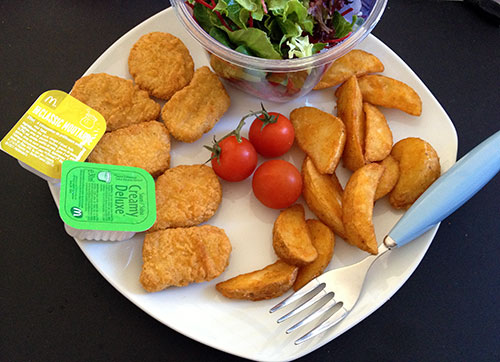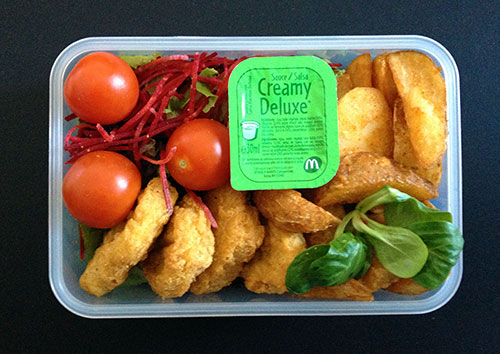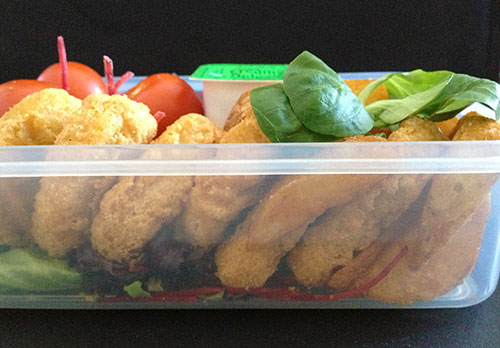Bento 101 (Getting Into the Bento Making Habit) Part 2a: What do I put it in?
Hi Bento 101 followers! Hopefully you have at least gotten a start on the list of your favorite, bento/packed lunch-friendly foods as described in the first lesson. You may want to keep the list lying around and add to it as inspiration strikes. This approach works pretty well for me, and it's actually how I think up up the bento-friendly recipes I add to this site.
Let's move on to the next topic: what to put your bento lunch in. We will get into more detail about this next week, since many people in my experience get stuck on this point. Some people go out and get a bento box and find it too small, or too big, or just not usable for some reason. Others look at the tiny looking boxes pictured online and think, "no way am I going to be full eating just that". Then there are people who want to lose or maintain their weights with bento lunches and think that getting a tiny one is the answer. In other words, there's quite a bit of confusion.
So we're going to work on that container question. To start with, I want to work on that 'a bento box is too big/too small' perception for a bit. Most of us are used to seeing food spread out on a flat plate, but not packed in a box. But a plate is basically two-dimensional (diameter or width x length), with no rules or restrictions as to how high you can pile up the food in the 3rd dimension. This applies even to deeper food containers like bowls, except for liquid foods which will spill out once they go over the rim. Here Roy (played by Richard Dreyfuss) exceeds the expected limits of the third dimension of his dinner plate in the classic sci-fi movie Close Encounters Of The Third Kind.
A container like a bento box, on the other hand, has 3 clearly defined dimensions - width, length and height. If you spread out your food in a bento box as you might on a plate leaving lots of air space above, your food is going to shift around in there during transit and look messy by the time you open it up at lunchtime. But if you overstuff the box and can't close the lid, that's a problem too.
The ideal way to fill a bento box you'll be porting around in your backpack or briefcase for a while is to pack it as tightly as possible, as high as possible to the rim while still being closeable, so that the food has little chance to shift around and get messy. This means that for most foods a pretty small looking bento box will actually hold quite a lot of food.
Let me show this to you in pictures. Here is an ordinary dinner plate that I've loaded up with a typical McDonald's spread of Chicken McNuggets, potato wedges and a small salad. Note that I'm not suggesting by any means that this is a healthy meal (the tiny salad doesn't really improve it much), but I decided to use McDonald's food for this demonstration since I'm assuming most readers worldwide are familiar with them, and how big a Chicken McNugget is. (Also, after shooting the photos I realized that the potato wedges aren't sold at all McDonald's, including in the U.S. Here they are on the McDonald's France site if you're interested - they're called "Les Deluxe Potatoes" and are just your normal fried potato wedges, coated with some mildly spicy powder. They're pretty good actually.)
Anyway, so a McNuggets meal on a plate. The plate is around 28 cm / 11 inches in diameter (it's a square-ish plate). There are 6 McNuggets, a regular portion of potato wedges, the sauces that came with them, and a small salad still in the plastic container it came in. I've added a couple of cherry tomatoes for color. I think many people would feel fairly satisfied after eating all of this.

For this demonstration this plastic container, which can contain up to 630 ml of liquid (see how to determine the holding capacity of a bento box (or any other container)) and measures 12.6 x 5.8 x 18 cm (5" x 2.3" x 7"). It's a box made by Thermos with a snap-lock lid by the way - plain but practical. Size-wise it would be classified as 'medium' in bento box terms.

Even though the box is much smaller than the dinner plate in its width and length, due to its height I could get just about all the food that was spread out on the latter into the box. (I couldn't get all the salad in there, but it wouldn't fit without the container's height on the plate either.)

From the side you can see how this '3-dimensional packing' is done, by lining up the McNuggets soldier-fashion instead of flat. Although you can't see it here, the mustard sauce packet is stacked under the Creamy Sauce packet.

Assignment no. 2: Packing in the third dimension
This leads us to your 2nd assignment. Sometime in the next few days, take a meal - lunch or dinner - that you have arranged on a plate. Pick a meal that has mostly stuff that you might pack for lunch (as per your Assignment 1 list), that isn't very liquid like soup or stew for this purpose. Take any empty food container you have and measure its capacity by filling it with water and emptying the water into a measuring cup (see how to determine the holding capacity of a bento box again). Now try packing your mealinto the container, as compactly as possible, using the third dimension or height. If your chosen container was too small, just leave the food that didn't fit on the plate. If your container was too big though, pack the food compactly anyway to see how much space is left over. (And of course you should eat the meal after you're done playing with it.)
This exercise should give you a fairly good idea of what size of container you need for your favorite kinds of meals. There are different kinds of meals you can pack for bento of course, but for now the main objective is to get a general idea of what a box can hold as compared to a plate.
Sharing your results
If you like (this is not mandatory) take a photo of your packing experiment results and post them to the Facebook page, to the JustBento Twitter account using the hashtag #bento101, or to the Flickr group. Please add somewhere in your description that the pic is for Assignment no. 2. Or, post a link to where you've uploaded it on your blog, Tumblr, Instagram page, etc. in the comments!
So that's it. I hope you'll have fun with this assignment, and I'll see you next week!
If you enjoyed this article, please consider supporting this site by becoming my patron via Patreon.
